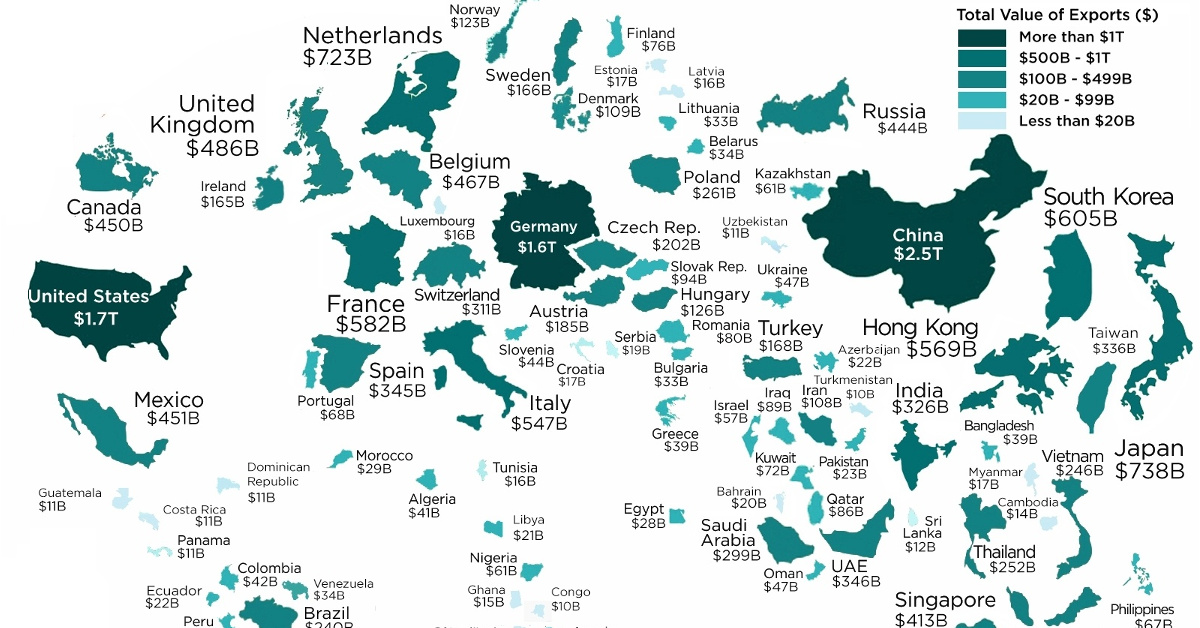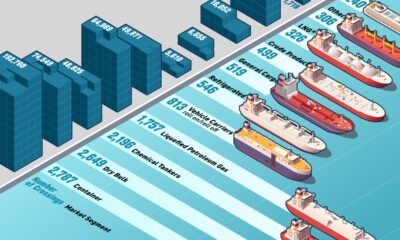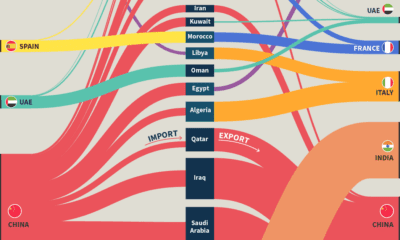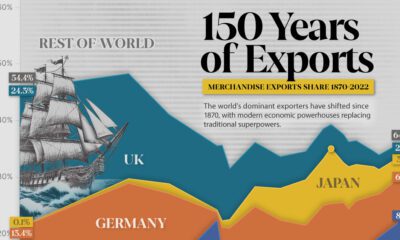Markets
Mapped: The World’s Largest Exporters in 2018
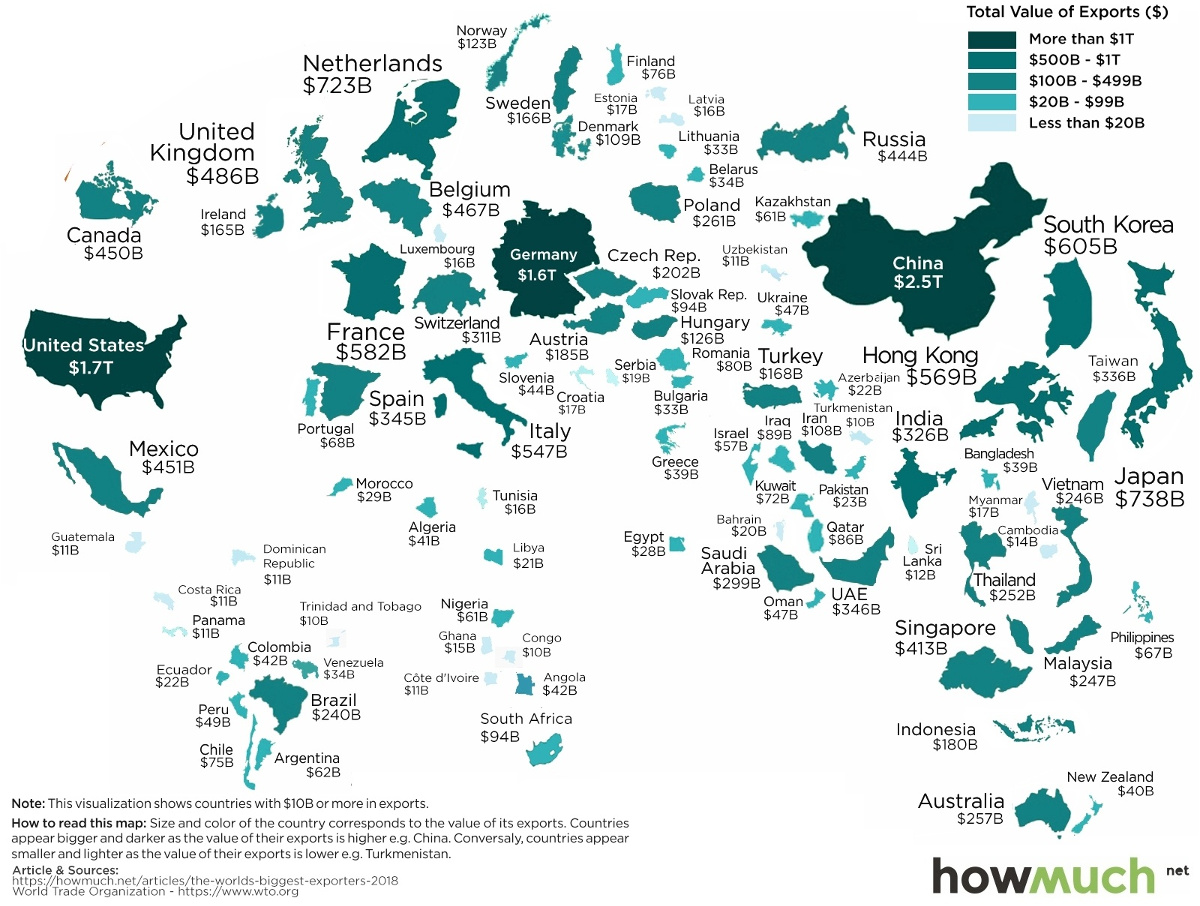
Visualizing the World’s Largest Exporters in 2018
Trillions of dollars of goods get traded around the world every year.
In 2018, total global exports exceeded $19 trillion, including specialized goods falling into almost every possible category imaginable.
Whether you’re talking about German cars, Bangladeshi t-shirts, Saudi oil, or Swiss milk chocolate, just about anything is available on the world market for a price – and the world’s largest exporting countries aim to take advantage.
Ranked: The 15 Largest Exporters in 2018
Today’s visualization comes to us from HowMuch.net, and it resizes countries based on their most recent export numbers, as per data from the World Trade Organization (WTO).
Let’s take a look at how the field breaks down:
| Rank | Country | Exports (2018, $M) | Share of Global Total |
|---|---|---|---|
| #1 | 🇨🇳 China | $2,487,045 | 12.8% |
| #2 | 🇺🇸 United States | $1,664,085 | 8.6% |
| #3 | 🇩🇪 Germany | $1,560,816 | 8.0% |
| #4 | 🇯🇵 Japan | $738,403 | 3.8% |
| #5 | 🇳🇱 Netherlands | $722,668 | 3.7% |
| #6 | 🇰🇷 Korea, Rep. | $604,860 | 3.1% |
| #7 | 🇫🇷 France | $581,816 | 3.0% |
| #8 | 🇭🇰 Hong Kong, China | $569,241 | 2.9% |
| #9 | 🇮🇹 Italy | $546,643 | 2.8% |
| #10 | 🇬🇧 United Kingdom | $485,711 | 2.5% |
| #11 | 🇧🇪 Belgium | $466,724 | 2.4% |
| #12 | 🇲🇽 Mexico | $450,572 | 2.3% |
| #13 | 🇨🇦 Canada | $449,845 | 2.3% |
| #14 | 🇷🇺 Russia | $444,008 | 2.3% |
| #15 | 🇸🇬 Singapore | $412,629 | 2.1% |
Leading the list of the world’s largest exporters is China, with a whopping $2.5 trillion of goods sent abroad in 2018. If you add in Hong Kong’s numbers, China holds 15.7% of the global export total — roughly equal to Japan, Netherlands, South Korea, France, and Singapore combined.
Coming next on the list is the U.S., which exports about $1.7 trillion of goods each year. After that comes Germany, which is the only other country to export over $1 trillion of goods per year.
Comparing U.S. and Chinese Exports
What does China export, and how does that compare to a more developed economy such as the United States?
Using data from MIT’s Observatory of Economic Complexity, we can see the broad breakdown of exports in both countries:
| 🇨🇳 China (Exports) | Share | 🇺🇸 U.S. (Exports) | Share | |
|---|---|---|---|---|
| Machines | 48.5% | Machines | 22.1% | |
| Textiles | 9.9% | Transportation | 14.9% | |
| Metals | 7.1% | Chemical Products | 13.7% | |
| Chemical Products | 4.9% | Mineral Products | 11.4% | |
| Plastics and Rubbers | 4.0% | Instruments | 6.8% | |
| Instruments | 3.2% | Plastics and Rubbers | 5.5% | |
| Transportation | 3.2% | Vegetable Products | 5.1% | |
| Footwear and Headwear | 2.6% | Metals | 4.8% | |
| Stone and Glass | 1.7% | Foodstuffs | 3.3% | |
| Mineral Products | 1.3% | Precious Metals | 3.1% | |
| Animal Hides | 1.2% | Animal Products | 2.2% | |
| Other/Misc | 12.4% | Paper Goods | 2.1% | |
| Textiles | 1.7% | |||
| Other/Misc | 3.3% |
On first glance, it’s clear that China’s exports are reliant on one heavy-hitting category (Machines) to drive a whopping 48.5% of total export value. Within that broad category of machines, there are many narrower categories, including:
- Broadcasting equipment (9.6% of total exports)
- Computers (6.1%)
- Office machine parts (3.8%)
- Integrated circuits (3.3%)
- Telephones (2.6%)
- Electrical transformers (1.3%)
- Semiconductor devices (1.2%)
- Video displays (1.1%)
For the United States, machines are still important at 22.1% of exports, but three other broad categories also surpass the 10% mark: transportation, chemical products, and mineral products. This means the U.S. is generally more diversified in its major exports.
For more, see the largest export of each state on this map.
Markets
The European Stock Market: Attractive Valuations Offer Opportunities
On average, the European stock market has valuations that are nearly 50% lower than U.S. valuations. But how can you access the market?

European Stock Market: Attractive Valuations Offer Opportunities
Europe is known for some established brands, from L’Oréal to Louis Vuitton. However, the European stock market offers additional opportunities that may be lesser known.
The above infographic, sponsored by STOXX, outlines why investors may want to consider European stocks.
Attractive Valuations
Compared to most North American and Asian markets, European stocks offer lower or comparable valuations.
| Index | Price-to-Earnings Ratio | Price-to-Book Ratio |
|---|---|---|
| EURO STOXX 50 | 14.9 | 2.2 |
| STOXX Europe 600 | 14.4 | 2 |
| U.S. | 25.9 | 4.7 |
| Canada | 16.1 | 1.8 |
| Japan | 15.4 | 1.6 |
| Asia Pacific ex. China | 17.1 | 1.8 |
Data as of February 29, 2024. See graphic for full index names. Ratios based on trailing 12 month financials. The price to earnings ratio excludes companies with negative earnings.
On average, European valuations are nearly 50% lower than U.S. valuations, potentially offering an affordable entry point for investors.
Research also shows that lower price ratios have historically led to higher long-term returns.
Market Movements Not Closely Connected
Over the last decade, the European stock market had low-to-moderate correlation with North American and Asian equities.
The below chart shows correlations from February 2014 to February 2024. A value closer to zero indicates low correlation, while a value of one would indicate that two regions are moving in perfect unison.
| EURO STOXX 50 | STOXX EUROPE 600 | U.S. | Canada | Japan | Asia Pacific ex. China |
|
|---|---|---|---|---|---|---|
| EURO STOXX 50 | 1.00 | 0.97 | 0.55 | 0.67 | 0.24 | 0.43 |
| STOXX EUROPE 600 | 1.00 | 0.56 | 0.71 | 0.28 | 0.48 | |
| U.S. | 1.00 | 0.73 | 0.12 | 0.25 | ||
| Canada | 1.00 | 0.22 | 0.40 | |||
| Japan | 1.00 | 0.88 | ||||
| Asia Pacific ex. China | 1.00 |
Data is based on daily USD returns.
European equities had relatively independent market movements from North American and Asian markets. One contributing factor could be the differing sector weights in each market. For instance, technology makes up a quarter of the U.S. market, but health care and industrials dominate the broader European market.
Ultimately, European equities can enhance portfolio diversification and have the potential to mitigate risk for investors.
Tracking the Market
For investors interested in European equities, STOXX offers a variety of flagship indices:
| Index | Description | Market Cap |
|---|---|---|
| STOXX Europe 600 | Pan-regional, broad market | €10.5T |
| STOXX Developed Europe | Pan-regional, broad-market | €9.9T |
| STOXX Europe 600 ESG-X | Pan-regional, broad market, sustainability focus | €9.7T |
| STOXX Europe 50 | Pan-regional, blue-chip | €5.1T |
| EURO STOXX 50 | Eurozone, blue-chip | €3.5T |
Data is as of February 29, 2024. Market cap is free float, which represents the shares that are readily available for public trading on stock exchanges.
The EURO STOXX 50 tracks the Eurozone’s biggest and most traded companies. It also underlies one of the world’s largest ranges of ETFs and mutual funds. As of November 2023, there were €27.3 billion in ETFs and €23.5B in mutual fund assets under management tracking the index.
“For the past 25 years, the EURO STOXX 50 has served as an accurate, reliable and tradable representation of the Eurozone equity market.”
— Axel Lomholt, General Manager at STOXX
Partnering with STOXX to Track the European Stock Market
Are you interested in European equities? STOXX can be a valuable partner:
- Comprehensive, liquid and investable ecosystem
- European heritage, global reach
- Highly sophisticated customization capabilities
- Open architecture approach to using data
- Close partnerships with clients
- Part of ISS STOXX and Deutsche Börse Group
With a full suite of indices, STOXX can help you benchmark against the European stock market.

Learn how STOXX’s European indices offer liquid and effective market access.

-

 Economy2 days ago
Economy2 days agoEconomic Growth Forecasts for G7 and BRICS Countries in 2024
The IMF has released its economic growth forecasts for 2024. How do the G7 and BRICS countries compare?
-

 Markets1 week ago
Markets1 week agoU.S. Debt Interest Payments Reach $1 Trillion
U.S. debt interest payments have surged past the $1 trillion dollar mark, amid high interest rates and an ever-expanding debt burden.
-

 United States2 weeks ago
United States2 weeks agoRanked: The Largest U.S. Corporations by Number of Employees
We visualized the top U.S. companies by employees, revealing the massive scale of retailers like Walmart, Target, and Home Depot.
-

 Markets2 weeks ago
Markets2 weeks agoThe Top 10 States by Real GDP Growth in 2023
This graphic shows the states with the highest real GDP growth rate in 2023, largely propelled by the oil and gas boom.
-

 Markets2 weeks ago
Markets2 weeks agoRanked: The World’s Top Flight Routes, by Revenue
In this graphic, we show the highest earning flight routes globally as air travel continued to rebound in 2023.
-

 Markets2 weeks ago
Markets2 weeks agoRanked: The Most Valuable Housing Markets in America
The U.S. residential real estate market is worth a staggering $47.5 trillion. Here are the most valuable housing markets in the country.
-

 Mining1 week ago
Mining1 week agoGold vs. S&P 500: Which Has Grown More Over Five Years?
-

 Markets2 weeks ago
Markets2 weeks agoRanked: The Most Valuable Housing Markets in America
-

 Money2 weeks ago
Money2 weeks agoWhich States Have the Highest Minimum Wage in America?
-

 AI2 weeks ago
AI2 weeks agoRanked: Semiconductor Companies by Industry Revenue Share
-

 Markets2 weeks ago
Markets2 weeks agoRanked: The World’s Top Flight Routes, by Revenue
-

 Demographics2 weeks ago
Demographics2 weeks agoPopulation Projections: The World’s 6 Largest Countries in 2075
-

 Markets2 weeks ago
Markets2 weeks agoThe Top 10 States by Real GDP Growth in 2023
-

 Demographics2 weeks ago
Demographics2 weeks agoThe Smallest Gender Wage Gaps in OECD Countries
